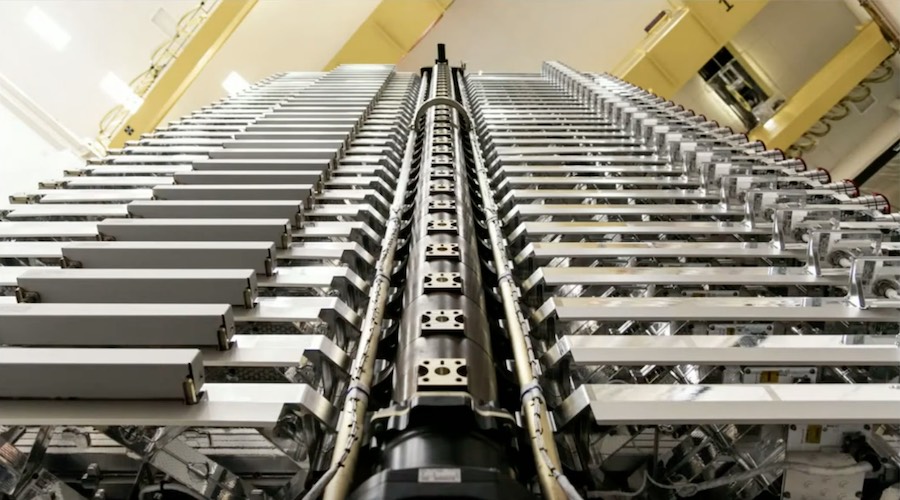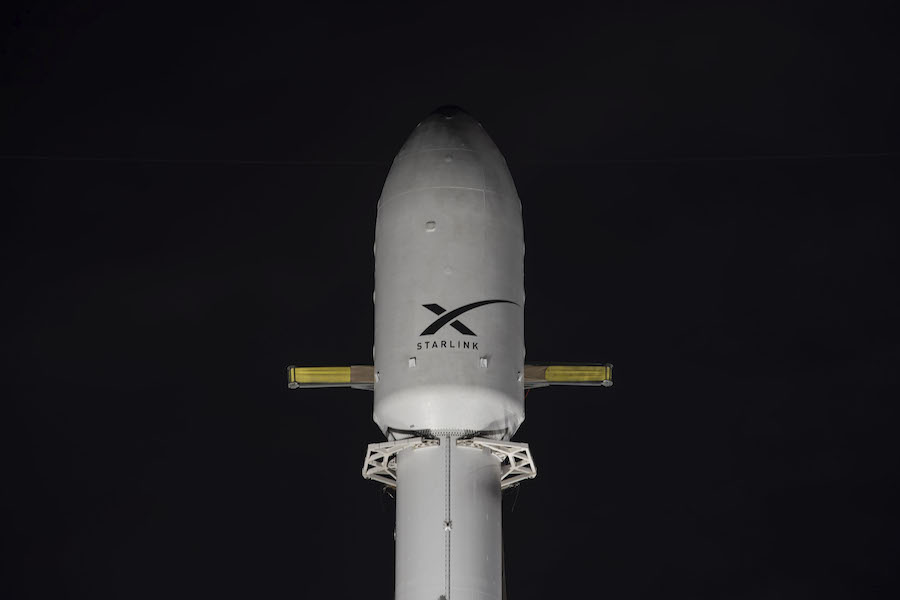
A batch of 51 Starlink internet spacecraft, debuting new laser inter-satellite links, is set for liftoff Monday night from Vandenberg Space Force Base in California on SpaceX’s first dedicated Starlink mission from the West Coast.
The 51 satellites will begin populating a new shell within SpaceX’s Starlink network, following the completion of the first orbital shell after a series of dedicated launches from Florida over two years between May 2019 and May of this year.
The Starlink satellites launched so far give the network reach to high latitudes, but don’t provide global coverage.
“We’ve completed the first element of our network …which basically gets us to plus or minus 50 degrees, 53 degrees, 55 degrees (latitude),” said Gwynne Shotwell, SpaceX’s president and chief operating officer, during a panel discussion at the Space Symposium last month.
The next phase of the Starlink program, beginning with Monday’s launch, will expand the coverage to the polar regions.
“We were hoping to do so a little bit sooner, but we’re working on our laser communication terminals,” Shotwell said.
Since May, SpaceX has rushed to complete development of new inter-satellite laser terminals to put on all future Starlink satellites. The laser crosslinks, which have been tested on a handful of Starlink satellites on prior launches, will reduce the reliance of SpaceX’s internet network on ground stations.
The ground stations are expensive to deploy, and come with geographical — and sometimes political — constraints on where they can be positioned. Laser links will allow the Starlink satellites to pass internet traffic from spacecraft to spacecraft around the world, without needing to relay the signals to a ground station connected to a terrestrial network.
That will enable the Starlink fleet to reach internet users in polar regions. The laser links could also reduce the network’s latency, or the time it takes for a signal to travel between destinations.
The 51 new Starlink satellites are stacked inside the payload shroud of a SpaceX Falcon 9 rocket for liftoff at 8:55:50 p.m. PDT (11:55:50 p.m. EDT) Monday, or 0355 GMT Tuesday.
The Falcon 9 will blast off from Space Launch Complex 4-East at Vandenberg and head south-southeast over the Pacific Ocean, flying parallel to the coast of Baja California to target an orbit inclined 70 degrees to the equator.
One of SpaceX’s rocket landing platforms, named “Of Course I Still Love You,” is stationed a few hundred miles downrange in the Pacific Ocean for landing of the Falcon 9’s first stage booster. The booster on this flight is designated B1049, and is making its 10th trip to space, tying a record for the most-flown rocket in SpaceX’s inventory.
The Falcon 9’s first stage, powered by nine kerosene-fueled Merlin engines, will burn for two-and-a-half minutes before shutting down and separating to begin descent to the drone ship, where landing is scheduled less than nine minutes after liftoff. The drone ship will return the rocket to the Port of Long Beach in California for refurbishment and assignment to another mission.
The second stage’s single Merlin engine, fitted with an expansion nozzle for in-space firings, will ignite for six minutes to place the 51 Starlink satellites into orbit.
Deployment of the Starlink satellites is scheduled at T+plus 15 minutes, 32 seconds, according to a mission timeline released by SpaceX.
A successful launch Monday night from California will clear the way for SpaceX’s next mission, set for liftoff from Florida Wednesday night, carrying the all-private Inspiration4 crew mission into low Earth orbit.
Here are some statistics on the Falcon 9 launch Monday night:
- 125th launch of a Falcon 9 rocket since 2010
- 133rd launch of Falcon rocket family since 2006
- 10th launch of Falcon 9 booster B1049
- 30th dedicated launch of Starlink satellites
- 17th SpaceX launch from Vandenberg Space Force Base
- 70th flight of a reused Falcon 9 booster
- 22nd Falcon 9 launch of 2021
- 22nd orbital launch by SpaceX in 2021
- 4th orbital launch attempt based out of Vandenberg in 2021
The launch Monday night will bring the total number of Starlink spacecraft SpaceX has launched to 1,791 satellites, adding to the largest fleet ever put into orbit. A tabulation by Jonathan McDowell, an astronomer and respected tracker of spaceflight activity, shows SpaceX currently has 1,420 operational Starlink satellites, with more than 100 additional craft moving into their operational positions in orbit.

The 51 new Starlink satellites will separate from the Falcon 9 launcher in an elongated orbit between 132 miles and 213 miles (213-by-343 kilometers). The spacecraft will turn on their krypton-fueled plasma thrusters to maneuver into their final circular orbit at an altitude of 354 miles (570 kilometers).
Most of the Starlink satellites launched so far have deployed into a 341-mile-high (550-kilometer), 53-degree inclination orbit, the first of five orbital “shells” the company plans to complete full deployment of the Starlink network.
With that shell on the verge of having more than 1,500 active satellites, SpaceX is transitioning to a new phase of the Starlink program.
The completion of the first Starlink “shell” enables the network to provide high-speed, low-latency internet services to lower latitudes, such as the southern United States. The partial deployment of satellites into the first orbital shell initially provided service over northern regions of the United States, Canada, and Europe, as well as higher-latitude regions in the southern hemisphere.
SpaceX, founded and led by billionaire Elon Musk, is currently providing interim internet services through the Starlink satellites to consumers who have signed up for a beta testing program.
Aside from the 53-degree and 70-degree orbital shells, SpaceX’s other Starlink layers will include 1,584 satellites at 335 miles (540 kilometers) and an inclination of 53.2 degrees, and 520 satellites spread into two shells at 348 miles (560 kilometers) and an inclination of 97.6 degrees.
SpaceX builds Starlink satellites on an assembly line in Redmond, Washington.
The company aims to launch Starlink missions from Vandenberg at a pace of one flight per month. Starlink launches from Florida’s Space Coast are expected to resume as soon as October.
SpaceX has regulatory approval from the Federal Communications Commission for approximately 12,000 Starlink satellites. The company’s initial focus is on launching 4,400 satellites on a series of Falcon 9 rocket flights. SpaceX’s next-generation launcher, a giant rocket called the Starship, could also be tasked with launching hundreds of Starlink satellites on a single mission.
Echoing previous comments from Musk, Shotwell said last month SpaceX is concentrating on providing Starlink service to a small percentage of the internet service market unreachable with conventional fiber connections.
“We’re looking forward to continuing to enhance the network by putting more capacity in space, and really looking forward to truly connect those that are very difficult to connect– the 3 to 5% where fiber just does not make sense,” she said.
“Customers are great at selecting great service and great value, so we will find out over the next five or so years what is too much, and what’s not too much,” Shotwell said. “I do believe that there is insatiable demand for data.”
Shotwell said last month that SpaceX continues technology development to reduce the cost of user terminals it sends out to Starlink customers. SpaceX charges $499 for a Starlink kit, which includes a circular antenna, a modem, and other gear.
But Shotwell said earlier this year it costs around $1,500 to produce each user terminal. That’s already a reduction from the cost off the first version.
“I can say, not proudly, that with every customer we acquire, we lose money on the user terminal because the cost of that user terminal is higher than the average customer can afford,” Shotwell said last month.
Most elements of the Starlink architecture, such as SpaceX’s use of mass-produced satellites and reusable rockets, have helped keep costs down.
“Reusability was key, actually, to deploying this constellation, and our satellite technology, we were able to bring that to a reasonable place with this generation of the constellation,” Shotwell said. “I don’t want to say we failed because we made tremendous progress on the user terminal, but those are still expensive.”
She said user terminals later this year will cost “roughly half” of the current terminal. “And we think we’ll be able to cut that in half yet again,” Shotwell said.
Shotwell said supply chain issues, such as the global computer chip shortage, have delayed the rollout of the new user terminals.
Email the author.
Follow Stephen Clark on Twitter: @StephenClark1.
